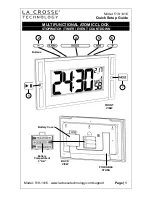
76
Timing, IRIG-B and Pulses
9.3
Output Signal Description
Both clock models can provide three different digital signals and one analog signal. Digital signals
consist of unmodulated IRIG-B, 1 PPS and Programmable Pulse. Analog consists of modulated
IRIG-B. 1 PPS is often used to synchronize another (unsynchronized) timing signal. Programmable
pulse modes are similar to 1 PPS only they have an adjustable period and pulse width with an
on-time rising edge. Programmable pulse modes include, seconds per pulse, pulse per hour, pulse
per day, single trigger (once per year), slow code with configurable pulse polarity.
9.3.1
IRIG-B Description
IRIG-B is a complete serial time code that occurs once per second and, depending on the
configuration, contains the day of year, hours, minutes, seconds, year and other important
information. The clock transmits (IRIG) Format B with four variations as seen in Table 9.2.
Designation
Signal Type
Code Components
B000
Pulse width code, No carrier
BCD
T OY
, CF, SBS
B003
Pulse width code, No carrier
BCD
T OY
, SBS
B004
Sine wave, amplitude modulated, 1 kHz
BCD
T OY
, BCD
Y EAR
, CF, SBS
B120
Sine wave, amplitude modulated, 1 kHz
BCD
T OY
, CF, SBS
B123
Sine wave, amplitude modulated, 1 kHz
BCD
T OY
, SBS
B124
Sine wave, amplitude modulated, 1 kHz
BCD
T OY
, BCD
Y EAR
, CF, SBS
Table 9.2: IRIG-B Time Code Types Available
The IRIG-B time code consists of 100 bits produced every second, 74 bits of which contain
various time, date, time changes and time quality information of the time signal. Consisting of
logic ones, zeros and reference bits, the time code provides a reliable method of transmitting time
to synchronize a variety equipment.
Three functional groups of bits in the IRIG-B time code are arranged in the following order:
Binary Coded Decimal (BCD), Control Function (CF) and Straight Binary Seconds (SBS). The
BCD group, with IEEE C37.118.1 OFF, contains only time information including the seconds,
minutes, hours and days, recycling yearly. With IEEE C37.118.1 ON, BCD adds year information.
The CF group contains other information including time quality, leap year, pending leap seconds
and parity. Reference bits separate the various components of the IRIG-B time code.
9.3.2
Modulated and Unmodulated IRIG-B
Figure 9.2 illustrates the primary differences between modulated and unmodulated IRIG-B. You
will notice that the while modulated IRIG-B is distinctive because of the 1 kHz sine wave carrier, it
is similar to unmodulated IRIG-B since the peak-to-peak values of the carrier follow the same form
as the peaks of the digital waveform, which contain the information. Note that the first reference
bit of both modulated and unmodulated IRIG-B is in sync with the rising edge of a 1 PPS signal.
Содержание 1200B
Страница 4: ...iv ...
Страница 135: ...A 3 Physical Dimensions 117 Figure A 2 Suggested Mounting of the GNSS Surge Arrester ...
Страница 143: ...B 7 Four Fiber Optic Outputs 125 Figure B 4 Jumper Locations ...
Страница 145: ...B 8 8 Channel High Drive IRIG B Amplifier 127 Figure B 5 8 High Drive Outputs Jumper Locations ...
Страница 161: ...B 10 Four Additional Outputs and Dry Contacts 25 50 Vdc 143 Figure B 7 Option Connector Signal Locations ...
Страница 212: ...Appendix E Statement of Compliance The following page is a statement of compliance that includes Model 1201B and 1201C ...
















































